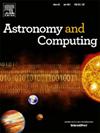Exploring the impact of dark energy in Finslerian black hole dynamics and observational features
IF 1.8
4区 物理与天体物理
Q2 ASTRONOMY & ASTROPHYSICS
引用次数: 0
Abstract
This study explores black hole dynamics within the framework of Finsler geometry, emphasizing the influence of the Finslerian constant and the quintessence dark energy parameter . By extending the conventional black hole metric with Finslerian corrections, we employ the osculating Riemannian approach and Barthel connection to derive a novel black hole metric, termed the Finsler Black Hole metric. The research investigates the effects of these modifications on photon trajectories, gravitational lensing, and shadow formation. The findings indicate that increasing enhances gravitational lensing, reduces the black hole shadow size, and produces distinct photon ring patterns. The analysis also reveals that the effective potential significantly influences photon orbits, with higher values pulling the photon sphere closer to the black hole. Furthermore, the study examines static and infalling spherical accretion models, showing that variations in and substantially impact the intensity distribution and geometry of black hole shadows. The inclusion of the Finslerian vector field adds complexity to the gravitational dynamics. These modifications introduce observable features that distinguish Finslerian black holes from those predicted by General Relativity. Additionally, the incorporation of dark energy through is shown to affect gravitational behavior and observable phenomena such as bending angles and critical impact parameters. This work provides a geometrical framework for understanding the interplay between Finsler geometry, dark energy, and black hole physics.
探索暗能量对芬斯勒黑洞动力学和观测特征的影响
本研究在芬斯勒几何框架下探讨黑洞动力学,强调芬斯勒常数η和典型暗能量参数ωs的影响。通过用芬斯勒校正扩展传统黑洞度规,我们采用了密切黎曼方法和Barthel连接,导出了一种新的黑洞度规,称为芬斯勒黑洞度规。研究了这些变化对光子轨迹、引力透镜和阴影形成的影响。结果表明,η的增加增强了引力透镜效应,减小了黑洞阴影的大小,并产生了独特的光子环图案。分析还表明,有效势V(r)显著影响光子轨道,η值越高,光子球越靠近黑洞。此外,该研究还检验了静态和落入球形吸积模型,表明η和ωs的变化对黑洞阴影的强度分布和几何形状有很大的影响。芬斯勒向量场β的加入增加了引力动力学的复杂性。这些修正引入了可观测的特征,将芬斯勒黑洞与广义相对论所预测的黑洞区分开来。此外,暗能量通过ωs的掺入被证明会影响引力行为和可观察到的现象,如弯曲角度和临界撞击参数。这项工作为理解芬斯勒几何、暗能量和黑洞物理之间的相互作用提供了一个几何框架。
本文章由计算机程序翻译,如有差异,请以英文原文为准。
求助全文
约1分钟内获得全文
求助全文
来源期刊

Astronomy and Computing
ASTRONOMY & ASTROPHYSICSCOMPUTER SCIENCE,-COMPUTER SCIENCE, INTERDISCIPLINARY APPLICATIONS
CiteScore
4.10
自引率
8.00%
发文量
67
期刊介绍:
Astronomy and Computing is a peer-reviewed journal that focuses on the broad area between astronomy, computer science and information technology. The journal aims to publish the work of scientists and (software) engineers in all aspects of astronomical computing, including the collection, analysis, reduction, visualisation, preservation and dissemination of data, and the development of astronomical software and simulations. The journal covers applications for academic computer science techniques to astronomy, as well as novel applications of information technologies within astronomy.
 求助内容:
求助内容: 应助结果提醒方式:
应助结果提醒方式:


